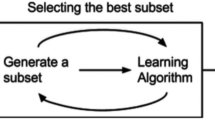Abstract
A major problem in medical science is attaining the correct diagnosis of disease in precedence of its treatment. For the ultimate diagnosis, many tests are generally involved. Too many tests could complicate the main diagnosis process so that even the medical experts might have difficulty in obtaining the end results from those tests. A well-designed computerized diagnosis system could be used to directly attain the ultimate diagnosis with the aid of artificial intelligent algorithms and hybrid system which perform roles as classifiers. In this paper, we describe a Ensemble model which uses MLP, RBF, LVQ models that could be efficiently solve the above stated problem. The use of the approach has fast learning time, smaller requirement for storage space during classification and faster classification with added possibility of incremental learning. The system was comparatively evaluated using different ensemble integration methods for breast cancer diagnosis namely weighted averaging, product, minimum and maximum integration techniques which integrate the results obtained by modules of ensemble, in this case MLP, RBF and LVQ. These models run in parallel and results obtained will be integrated to give final output. The best accuracy, sensitivity and specificity measures are achieved while using minimum integration technique.
Access this chapter
Tax calculation will be finalised at checkout
Purchases are for personal use only
Preview
Unable to display preview. Download preview PDF.
Similar content being viewed by others
References
American Cancer Society, Cancer Facts and Figures (2011-2012)
Weiss, S.I., Kulikowski, C.: Computer Systems That Learn: Classification and Prediction Methods from Statistics, Neural Networks, Machine Learning and Expert Systems. Morgan Kaufmann Publishers (1991)
Coleman, T.F., Li, Y.: Large Scale Numerical optimization. In: Proceedings of Workshop on Large Scale Numerical Optimization, Cornell University, New York (1989)
Andolina, V.F., Lille, S.L., Willison, K.M.: Mammographic Imaging: A Practical Guide, New York (1992)
Antani, S., Lee, D.J., Long, L.R., Thoma, G.R.: Evaluation of shape similarity measurement methods for spine X-ray images. Journal of Visual Communication & Image Representation 15, 285–302 (2004)
Clemen, R.: Combining forecasts: A review and annotated bibliography. International Journal of Forecasting, 559–583 (1989)
Yao, X., Liu, Y.: Neural networks for breast cancer diagnosis. In: Proceedings of the Congress on Evolutionary Computation, vol. 3, pp. 1767–1773 (August 2002)
Fogel, D.B., Wasson, E.C., Boughton, E.M., Porto, V.W., Angeline, P.J.: Linear and neural models for classifying breast masses. IEEE Transactions on Medical Imaging 17(3), 485–488 (1998)
Rahul, K., Anupam, S., Ritu, T., Janghel, R.R.: Breast cancer diagnostic system using artificial neural networks model. In: International Conference on Information Sciences and Interaction Sciences (ICIS), pp. 89–94 (2010)
Melin, P., Castillo, O.: Hybrid Intelligent Systems for Pattern Recognition Using Soft Computing. STUDFUZZ, vol. 172. Springer, Heidelberg (2005)
Bunke, H., Kandel, A. (eds.): Hybrid Methods in Pattern Recognition. World Scientific (2002)
Sivanandan, S.N., Deepa, S.N.: Principle of soft computing. Wiley India Private Limited (2007)
Nabil, E., Badr, A., Farag, I.: An Immuno-Genetic Hybrid Algorithm. Int. Journal of Computers, Communications & Control IV(4), 374–385 (2009)
Alcala, R., Nojima, Y.: Special issue on genetic fuzzy systems: new advances. Evolutionary Intelligence 2, 1–3 (2009)
Pena-Reyes, C.A., Sipper, M.: A fuzzy-genetic approach to breast cancer diagnosis. Artificial Intelligence in Medicine, 131–155 (1999)
Peña Reyes, C.A.: Breast Cancer Diagnosis by Fuzzy CoCo. In: Peña Reyes, C.A. (ed.) Coevolutionary Fuzzy Modeling. LNCS, vol. 3204, pp. 71–87. Springer, Heidelberg (2004)
Author information
Authors and Affiliations
Editor information
Editors and Affiliations
Rights and permissions
Copyright information
© 2014 Springer International Publishing Switzerland
About this paper
Cite this paper
Janghel, R.R., Shukla, A., Sharma, S., Gnaneswar, A.V. (2014). Evolutionary Ensemble Model for Breast Cancer Classification. In: Tan, Y., Shi, Y., Coello, C.A.C. (eds) Advances in Swarm Intelligence. ICSI 2014. Lecture Notes in Computer Science, vol 8795. Springer, Cham. https://doi.org/10.1007/978-3-319-11897-0_2
Download citation
DOI: https://doi.org/10.1007/978-3-319-11897-0_2
Publisher Name: Springer, Cham
Print ISBN: 978-3-319-11896-3
Online ISBN: 978-3-319-11897-0
eBook Packages: Computer ScienceComputer Science (R0)




